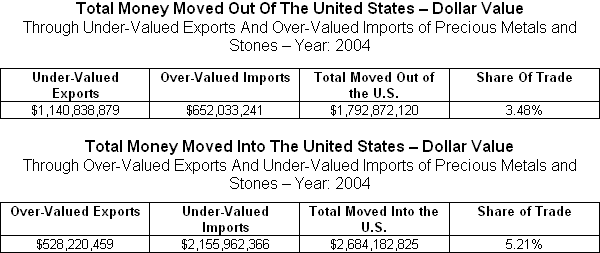Study Cites Money Laundering by U.S. Diamond Jewlery Retailers
May 25, 06
“FinCEN regulations powerless to stop illegal international gem trade,” notes a scary headline of an article written by Professor John Zdanowicz, Ph.D. that is featured in an authoritative money-laundering publication. The professor is one of
Referring to the new FinCEN AML/CFT rules for the diamond and jewelry sector, Professor Zdanowicz dismisses the effectiveness of these regulations. He says, “They do not focus on analyzing abnormally priced international trade transactions that result in moving money into or out of the
My gut feelings say that when it comes to the international diamond industry, the professor probably doesn’t understand its operations or its drivers. On the other hand, we may not fully understand the ramifications of his research methodology. For the moment, I find it difficult to reconcile his methods with my understanding of how the diamond trade works. Even if the professor’s conclusions were right, it doesn’t necessarily mean that there is a causal link between his methodology and his findings. Furthermore, I wonder if the researchers are aware of the Kimberley Process or that international trade values are being checked by customs officials all over the world. By the examples cited, the study seems to imply that the issue we have identified mainly applies to retailers. But this is not self-evident.
What is more interesting (and probably erroneous) is that the professor challenges the wisdom of FinCEN’s jewelry retail exemption, which, in most circumstances, allows retailers to operate without having an AML/CFT Compliance Program. Professor Zdanowicz, a professor of finance at
His explanation is as follows, “The transaction will require the money launderer to purchase diamonds, gold, rubies, sapphires, and emeralds from retail jewelers, who are exempt from the new FinCEN regulations because they sell "primarily" to the public. These purchases will be made with dirty cash and will be in amounts less than $10,000 per transaction to avoid a form 8300 filing. Two hundred purchases of $5,000 will convert $1 million of dirty cash into $1 million of precious gems or metals. The $1 million dollars of precious gems and metals are exported to a colluding partner in
Is that scenario possible? Yes. Is that scenario likely to happen? Here I categorically take issue with the professor. Looking at opportunity costs and doing a cost/benefit analysis of money laundering, getting stuck with two hundred pieces of jewelry to launder money is probably a most inefficient and very costly way to get your dirty money spread around the globe. There are far easier and more cost-effective methods. The professor clearly holds a different view: “The conclusions of an exclusive computer analysis of 2004 U.S. trade data (performed for prestigious Money Laundering Alert newsletter) revealed that $1.8 billion was moved out of the United States through false invoicing in precious metals and gems. The same analysis also revealed that $2.7 billion was moved into the

Source: Computer analysis for Money Laundering Alert by Dr. John Zdanowicz, a professor of
finance at Florida International University, in Miami, and a member of Money Laundering
Alert's Editorial Board of Advisors.
Professor Zdanowicz explains that his “study evaluated every reported import and export transaction in precious metals and gems between the
The analysis determined every
An Expert Advising the IRS; Research Financed by Government
According to the professor,
For our industry, the immediate problem arises from the professor’s unequivocal conclusion that, “the
The diamond trade may not be familiar with Professor Zdanowicz, but in the anti-money laundering community he is considered one of the greater experts, and his views are highly valued by the
The government awarded that research money to enable the researchers to, “build on their previous work, which will help determine policies that will allow the IRS to collect taxes due, but avoided under such pricing schemes.” It is believed that the practice of abnormal international trade pricing shifts profits and enables individuals and firms to avoid or reduce their
“If these suspicious transactions were investigated by the IRS, a significant amount of lost tax revenue could be collected,” Zdanowicz said at the time he was awarded the grant. According to Zdanowicz, “losses in
What is Abnormal? What is Abnormal in Diamonds?
In his methodology, the professor considers import and export prices to be abnormal if they deviate significantly above or below the pricing norms or the inter-quartile range, which is specified by IRS tax code. He also assumes that every dollar of taxable income shifted out of the
Every diamantaire knows that diamonds may range in values of only a few cents per carat to tens of thousands of dollars in carats. We believe that one shipment from the DRC or from
The diamond industry must take early note of the research; some of the problems can be solved by creating a greater awareness among diamond traders of the importance of international customs codes. These problems are mounting. To give an example totally unrelated to the Zdanowicz research, the Israeli government reported that in the past two years
So I have sympathy for some of the professor’s observations on customs codes, though he wants the codes to be more precise only to be able to detect deviations (and for government to collect more taxes and find launderers.) Says Zdanowicz, “The first problem with the
“During 2004 there were 130 product codes for
“A second problem with the
The conclusion of the professor is scary: “Money launderers and terrorists realize that the lack of regulations and monitoring of abnormal pricing in international trade of precious metals and gems is a "gold mine" for moving money across borders. The
Remembering al-Qaeda
Here the professor makes an unwarranted link between gem laundering and “another 9/11.” When there was flimsy evidence (one newspaper report) about an alleged diamond link between al-Qaeda and diamonds a few years ago, the U.S. Congress quickly passed the Clean Diamonds Act (Kimberley Process); whether the link was real or imaginary became totally irrelevant. Professor Zdanowicz’s findings may have a similar impact.
It is my understanding, based on a working paper published by the Center for International Business and Education Research (CIBER) at the
Then the researchers segment the total data set and enter the data for each individual transaction into a global price matrix. In that global price matrix, every country in the world is represented by over 230 columns, while every import harmonized code and every export harmonized code are represented by over 23,000 rows. The resulting matrix contains over five million cells. Each cell in the matrix contains the data on the population of transactions related to the
Analysis and Determining Abnormal Prices
The researchers employ the inter-quartile range as the benchmark to determine if a transaction price is considered abnormal. They say that in 1994, the United States IRS issued its 482 transfer pricing regulations and stipulated that the inter-quartile price range should be used to determine the validity of transfer prices in international trade. In the professor’s analysis, imports at prices exceeding the import upper-quartile price, and exports at prices below the lower export-quartile price are considered abnormal.
It must be noted that in its transfer pricing regulations, the IRS also stipulates that prices outside the inter-quartile range should be adjusted and brought back to the median price when determining the dollar adjustment of abnormally priced transactions. This opens up the possibility of the IRS perhaps coming into one’s door with data that probably has normal explanations.
I don’t see the Zdanowicz research and finding problematic on the micro level, as each importer and exporter will find it easy to explain the legitimate and normal transactions. My concern comes from the macro-level. Just as fears of al-Qaeda or the forthcoming Blood Diamonds movie from Hollywood may inspire the public and governments to react (whether or not there is a real need to), and, just as many years ago the industry – somehow belatedly – embraced NGO’s and brought them into the industry, we ought to consider engaging into dialogue with professors such as Dr. John Zdanowicz and his colleagues. The last thing the diamond industry can afford is being tainted with such far-reaching findings, which represent a broad and general accusation on the entire
The commitment of the international diamond industry towards full compliance with AML/CFT rules should not be allowed to be questioned. If there are problems, they can – and must – be addressed.
Have a nice weekend.